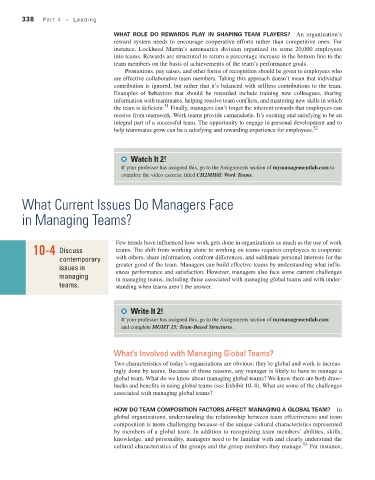Page 339 - Fundamentals of Management Myths Debunked (2017)_Flat
P. 339
338 Part 4 • Leading
WhaT roLe do reWardS pLay in Shaping TeaM pLayerS? An organization’s
reward system needs to encourage cooperative efforts rather than competitive ones. For
instance, Lockheed Martin’s aeronautics division organized its some 20,000 employees
into teams. Rewards are structured to return a percentage increase in the bottom line to the
team members on the basis of achievements of the team’s performance goals.
Promotions, pay raises, and other forms of recognition should be given to employees who
are effective collaborative team members. Taking this approach doesn’t mean that individual
contribution is ignored, but rather that it’s balanced with selfless contributions to the team.
Examples of behaviors that should be rewarded include training new colleagues, sharing
information with teammates, helping resolve team conflicts, and mastering new skills in which
51
the team is deficient. Finally, managers can’t forget the inherent rewards that employees can
receive from teamwork. Work teams provide camaraderie. It’s exciting and satisfying to be an
integral part of a successful team. The opportunity to engage in personal development and to
help teammates grow can be a satisfying and rewarding experience for employees. 52
Watch It 2!
If your professor has assigned this, go to the Assignments section of mymanagementlab.com to
complete the video exercise titled CH2MHill: Work Teams.
What Current Issues Do Managers Face
in Managing Teams?
Few trends have influenced how work gets done in organizations as much as the use of work
10-4 Discuss teams. The shift from working alone to working on teams requires employees to cooperate
contemporary with others, share information, confront differences, and sublimate personal interests for the
issues in greater good of the team. Managers can build effective teams by understanding what influ-
ences performance and satisfaction. However, managers also face some current challenges
managing in managing teams, including those associated with managing global teams and with under-
teams. standing when teams aren’t the answer.
Write It 2!
If your professor has assigned this, go to the Assignments section of mymanagementlab.com
and complete MGMT 15: Team-Based Structures.
What’s Involved with managing Global Teams?
Two characteristics of today’s organizations are obvious: they’re global and work is increas-
ingly done by teams. Because of those reasons, any manager is likely to have to manage a
global team. What do we know about managing global teams? We know there are both draw-
backs and benefits in using global teams (see Exhibit 10–8). What are some of the challenges
associated with managing global teams?
hoW do TeaM CoMpoSiTion FaCTorS aFFeCT Managing a gLoBaL TeaM? In
global organizations, understanding the relationship between team effectiveness and team
composition is more challenging because of the unique cultural characteristics represented
by members of a global team. In addition to recognizing team members’ abilities, skills,
knowledge, and personality, managers need to be familiar with and clearly understand the
53
cultural characteristics of the groups and the group members they manage. For instance,

